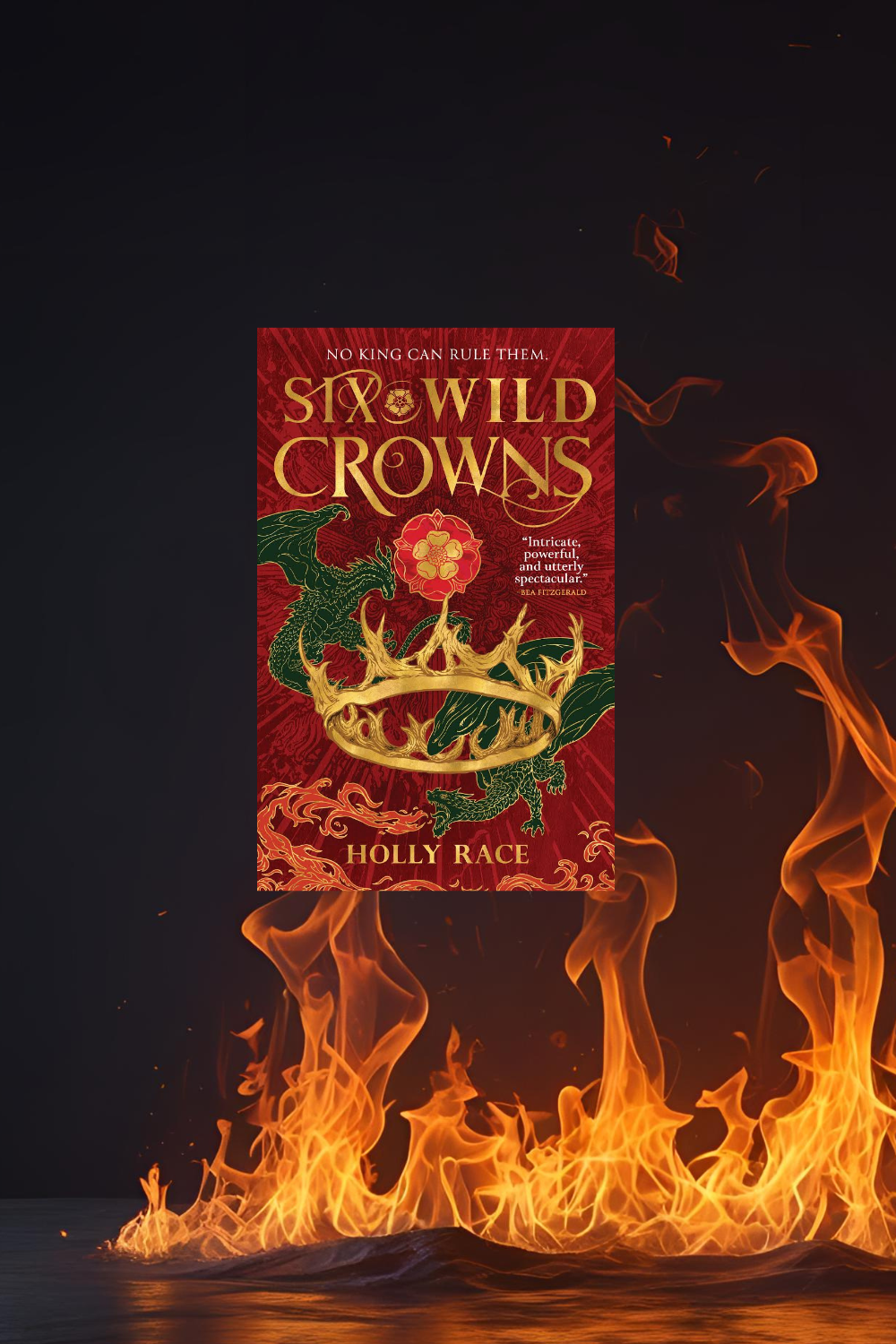Queens of Elben #1 | Fantasy | Published 2025
Overall rating: ★★★★☆ (4.5/5 stars)
Six Wilds Crowns is the first book in the Queens of Elben series, written by Holly Race and first published in 2025. It’s inspired by the six wives of Henry VIII.
The premise of this book seemed tailor made for me. I love history, especially Tudor England, and I love fantasy. And while this was not a perfect read, it was still amazing and I enjoyed it a lot.
Please note: This review contains spoilers. If you haven’t read the book and prefer to go in blind, consider returning after you’ve finished it.
Historically accurate?
If you are looking for historically accurate representations of the six queens of Henry VIII, this is not it. The six women are much more fantasy oriented, and they take power without truly wanting the power and are (mostly) easily swayed to do the right thing. Not to say that the women these characters are inspired by were not good women (lots of discussion out there on that, if you’re interested), but their lives had far less dragons in them and far more court navigation and compromises.
But while the characters and the story were not historically accurate, the stories of the six women were inspired by historical events, which does set up some expectations if you are aware of the history. For example, the book starts off with Seymour as a lady in waiting, but if you happen to know that Jane Seymour was one of the wives of Henry VIII, you might reasonably expect her to end up married to the King in this story too. I thought the author did a lovely job of balancing the expectations and delivering on them in a new way or subverting them cleverly.
The Story
In the kingdom of Elben, a magical tradition demands that the king must marry six queens and magically bind each to one of the island’s palaces to protect the kingdom from its enemies. The King is, of course, Henry, inspired by Henry VIII. We focus mostly on Boleyn as we follow her from her wedding to her apparent death. She marries Henry out of love, but quickly gathers there is something wrong with the land and the role of the queens. She starts to rebel and gather the other queens to her cause. Her first and strongest ally is Seymour. Initially sent to Boleyn’s court as a spy and assassin, Seymour unexpectedly catches the king’s eye—and Boleyn’s. Their relationship evolves from tension to an unlikely but powerful alliance.
The Issues
While this was a highly enjoyable read, there were some things that bothered me. The first and most obvious was the naming of the characters. All of the female characters go by their surnames and do not have names aside from them. I understand it would have been very difficult to have three Catherine’s and two Anne’s running around, just to name the most obvious problem, but I was rather bothered by this. My mind kept supplementing the first names. I wonder if it’s maybe a set-up for a later book in which the characters could take actual names for themselves? It is a minor issue to be sure, but one I couldn’t overlook for the whole book.
The other thing was romance, which felt just a bit lacking. Or, to be more precise, I felt as if the characters were instantly in love every time. This applies to Henry and Boleyn, Henry and Seymour, Seymour and Boleyn and even the hint of Cleaves and Seymour. Of course, it bothered me most in the case of Seymour and Boleyn. It’s a big plot point, as it influences most of Seymour’s actions throughout the plot. What I did find refreshing is that it’s established the love is one-sided, but this is just a fact of life. There’s no anger because of the unrequited love, just acceptance. It certainly feels as crucial because it motivates Seymour to care for the events of the plot, but I just wish it felt less like insta-love, honestly.
My final problem with the book was that I felt like time was very muddy. By the end of the book, two years have passed and I found it difficult to really place the passage of time throughout the book.
The Good Parts
I really enjoyed the play with history. The author took real people and events and used them as inspiration. She leaned heavily into the fact that all the queens were followed by rumours and stereotypes and played with it as a point in the story and as a way to keep the reader guessing. As stated before, major spoilers, but Seymour gets pregnant quite soon and I expected the story to deal with the fact that she would give birth to a son, but she instead decides not to have the baby, which I thought was an interesting twist. It was especially enjoyable as the real Seymour is often seen as very motherly, even though she died very soon after giving birth to her only son, and in this story, I feel like she is anything but motherly.
I also think every modern adaptation of Anna of Cleaves decides to paint her as the most independent woman ever, and quirky whenever she can be. The real Anna of Cleaves got a peaceful divorce and profited from it so she’s often seen as the one who got away and I feel like that is always used to the max in modern adaptations. Here she is a strong woman doing her thing, and I loved that.
I felt just a tad disappointed with how Catherine of Aragon was interpreted in this book, but that might be because she is my favourite. I do think that the real Catharine was a powerful woman with strong goals and I never got the impression something like love would ever give her pause in going after what she wanted. Then again, in this book, Aragon is also strong-willed and clever. The fact that she might love Henry is thrown out there, but she was brought up to think it was her duty to serve a man as a queen consort, and she isn’t able to break free from this throughout this book. She was looking out for her daughter and she was unwilling to exchange submission to one sovereign in favour of the other, which does speak of her practical side. She clearly tells Boleyn that she would have to be convinced that Boleyn would lead them into an era in which all six queens were equal, not one in which Henry was replaced by Boleyn.
I like how religion was once again central in the struggle for the land itself. It was a major point of contention in Tudor England and Europe too, and to see it translated like this into a fantasy world was intriguing.
Conclusion
All in all, I will very happily tune in for the next installment. I look forward to seeing what else is in store. An absolute recommendation from my side, and I’d love to hear your thoughts on the book!


Leave a Reply